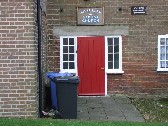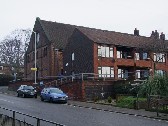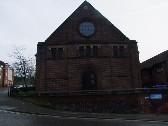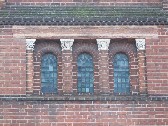| |
|
Silver
Road Baptist Church, Norwich We are not far from
the redundant St James the Less, now the Norwich Puppet
Theatre, on Herbert Rowley's inner ring road. Past one of
the best-preserved fragments of the medieval city wall,
Silver Road rises pleasingly towards Sprowston,
attractive Victorian terraces on either side, and
stunning views back to the Anglican Cathedral. Near the
top of the hill, this large structure comes into sight. I
had actually been looking for the Church of England
parish church of St Mary Magdalen fifty metres further
along, but that church is rather restrained in comparison
with this prominent castle of a chapel crowning the rise.
Silver
Street Baptist Church is a good example of that early
20th Century enthusiasm: an ecclesiastical village. That
is to say, several buildings for different Church
purposes built together on the same site, distinct but
joined together to make a structure larger than simply
the church itself. Seen from the north on Mousehold
Avenue, the long building stretches confidently below the
roadline, with what was probably the school becoming a
hall and then the church itself. To the south, the
complex is completed by modern apartments belonging to
the English Churches Housing Association.
| A
round plaque above a doorway in the north-west
corner is badly eroded, but gives the date of
construction as 1910. The style of the church is
largely neo-Norman, but with those neo-Byzantine
decorative details which had been made popular by
the construction in England a decade earlier of
the Catholic Westminster Cathedral. And there are
some beautiful details in the west window
capitals: a squirrel and a hare are echoes of
medieval ancestors. In contrast
to the grandeur of its west end, the entrance
today is a little doorway along the north side.
Unaccountably, This handsome structure was missed
by by both Pevsner and Bill Wilson, his revising
editor. This is a pity, because it would be
interesting to know who the architect was.
|
|
 |
|
|
|




